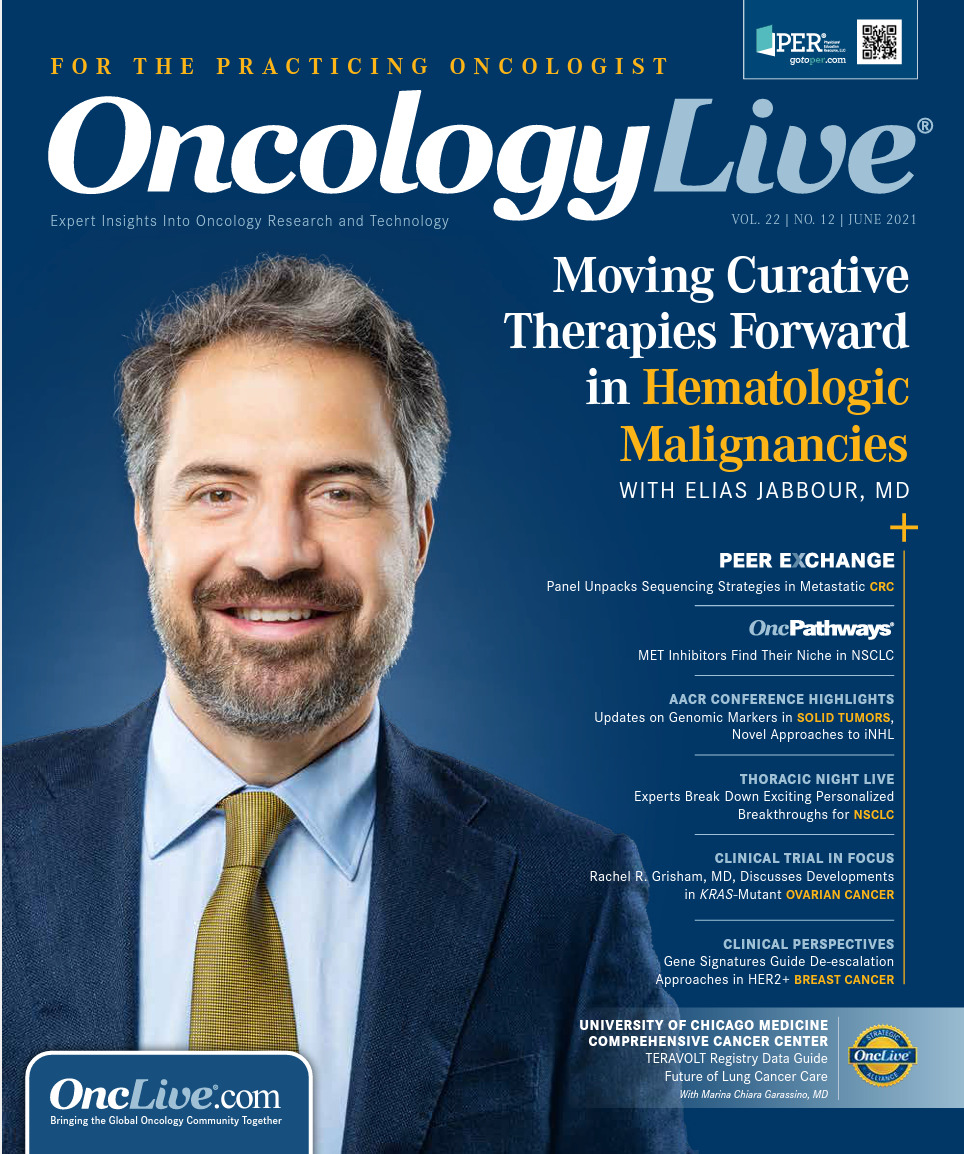Publication
Article
Oncology Live®
Experts Break Down Exciting Breakthroughs in NSCLC
Author(s):
Experts in lung cancer discuss advances with targeted therapies in non–small cell lung cancer, highlighting the latest and most pivotal data in the thoracic space and how the data apply to clinical practice.
Nicholas C. Rohs, MD

Treatment advances for patients with non–small cell lung cancer (NSCLC) who harbor HER2, EGFR, KRAS, and MET mutations have generated significant excitement and set the stage for further research aimed at generating better tolerated, more effective, and optimally sequenced treatments.
Nicholas C. Rohs, MD, an assistant professor of medicine, hematology, and medical oncology at the Icahn School of Medicine of Mount Sinai in New York, New York, moderated a discussion on advances with targeted therapies in NSCLC, highlighting the latest and most pivotal data in the thoracic space and how the data apply to clinical practice. This discussion was part of a recent edition of Thoracic Night Live, a video program in lung cancer from OncLive®.
Rohs was joined by Isabel Preeshagul, DO, MBS, an assistant professor and thoracic medical oncologist at Memorial Sloan Kettering Cancer Center, and Joshua K. Sabari, MD, an assistant professor and thoracic medical oncologist in the Department of Medicine at the Grossman School of Medicine at NYU Langone Health’s Perlmutter Cancer Center, both based in New York, New York.
HER2-Directed Advances
HER2 mutations account for 1% to 4% of all lung adenocarcinomas, Rohs said, which has made the data from the phase 2 DESTINY-Lung01 study (NCT03505710) with fam-trastuzumab deruxtecan-nxki (Enhertu) all the more exciting. The trial was divided into 2 cohorts of patients with HER2 overexpression and an activating HER2 mutation.
At the 2020 American Society for Clinical Oncology Virtual Scientific Program, findings from the mutation cohort (n = 42) were presented, demonstrating an objective response rate (ORR) of 61.9% (95% CI, 45.6%-76.4%), a disease control rate (DCR) of 90.5% (95% CI, 77.4%97.3%), and a median progression-free survival (PFS) of 14 months with the antibody-drug conjugate (ADC).1
“All you need to do is look at the waterfall plot, which speaks for itself,” Preeshagul said.
Isabel Preeshagul, DO, MBS

The data, which Rohs called “pretty exciting,” led to the incorporation of the agent into the National Comprehensive Cancer Network guidelines for patients with pretreated HER2-mutant advanced NSCLC. Additionally, these data provided the basis for an FDA breakthrough therapy designation for the treatment of patients with metastatic NSCLC whose tumors have a HER2 mutation and who had disease progression on or after platinum-based therapy.2
Findings from the cohort of patients with HER2 overexpression, defined as immunohistochemistry 2+ and 3+, were presented at the 2020 World Conference on Lung Cancer (2020 WCLC) and showed an ORR by independent central review of 24.5% (95% CI, 13.3%-38.9%) and a DCR of 69.4% (95% CI, 3.2-not estimable [NE]) in 49 evaluable patients. The median duration of response (DOR) was 6.0 months.3
Regarding adverse effects (AEs), Rohs pointed to the increased risk for pneumonitis, including grade 5 events. Pneumonitis is “not common, but it’s something we’ll have to deal with [when using trastuzumab deruxtecan],” Sabari said. He added that none of the patients he has treated with the drug to date have developed pneumonitis.
“The pneumonitis for this drug does not worry me as much as using a combination of a PD-1 inhibitor and a CTLA-4 inhibitor,” Sabari said, adding that the administration of a PD-1/PD-L1 inhibitor should be avoided in the frontline setting, if possible, to reduce the risk of interstitial lung disease.
Updates in EGFR+ NSCLC
Amivantamab-vmjw (Rybrevant), a bispecific antibody of EGFR and c-MET, has opened the door for agents designed to treat an underserved subset of patients with NSCLC whose disease harbors EGFR exon 20 insertion mutations.
Data from the phase 1 CHRYSALIS trial (NCT02609776), presented during the 2020 WCLC, demonstrated an ORR by blinded independent central review of 40% (95% CI, 29%-51%) and a clinical benefit rate of 74% in 81 patients,4 which Sabari called “impressive.” In terms of safety, Sabari said amivantamab is a “relatively well-tolerated medication overall.”
In May, the FDA granted accelerated approval to amivantamab for the treatment of patients with EGFR–positive metastatic NSCLC who harbor exon 20 insertion mutations and whose disease has progressed on or after platinum-based chemotherapy.5 The ongoing phase 3 MARIPOSA trial (NCT04487080), which is evaluating the addition of amivantamab to lazertinib, could enhance the central nervous system (CNS) penetration of the drug.
Another agent in development for patients with EGFR exon 20 insertion is the oral tyrosine kinase inhibitor (TKI) mobocertinib (TAK-788). The FDA granted the new drug application priority review in April.6
Findings from the phase 1/2 trial, which served as the basis for the application, showed a confirmed ORR of 43% (95% CI, 24%-63%) in 28 patients treated with mobocertinib 160 mg. The median DOR was 14 months (95% CI, 5-not reached), and all 12 patients had a confirmed partial response. The median PFS was 7.3 months (95% CI, 4.4-15.6).7
Updated findings from the study were presented at the 2021 ASCO Annual Meeting. In platinum-pretreated patients (n = 114), the confirmed ORR by independent review committee (IRC) assessment was 28% (95% CI, 20%-37%); all responses were partial responses (PRs). By investigator assessment, the confirmed ORR was 35% (95% CI, 26%-45%); the complete response (CR) rate was less than 1%, and the PR rate was 34%.
The median DOR was 17.5 months (95% CI, 7.4-20.3) by IRC and 11.2 months (95% CI, 5.6-not evaluable [NE]) by investigator assessment. The confirmed DCR was 78% (95% CI, 69%-85%) by IRC and investigator assessment.
The median overall survival was 24.0 months (95% CI, 14.6-28.8), and the median PFS was 7.3 months (95% CI, 5.5-9.2).8
Preclinical activity of the agent does not show substantial CNS penetration; however, Sabari noted that comparative efficacy and high rate of rash and diarrhea have led to less excitement about the drug.
“Thinking about strategic combinations that have great CNS activity and also potentially have resistance mechanism coverage is going to be really important going forward,” Sabari said.
Joshua K. Sabari, MD

What's New With KRAS G12C?
KRAS G12C mutations account for approximately 13% of all lung adenocarcinomas, Rohs said, and novel KRAS inhibitors are needed to improve outcomes for these patients and fill an unmet need.
On May 28, 2021, the FDA granted accelerated approval to sotorasib (Lumakras) for the treatment of patients with KRAS G12C–mutated locally advanced or metastatic NSCLC after at least 1 previous systemic therapy based on data from the phase 1/2 CodeBreaK 100 trial (NCT03600883).9 Findings from the trial, presented at the 2020 WCLC, showed that sotorasib elicited an ORR of 37.1% (95% CI, 28.6%-46.2%) in 124 heavily pretreated patients, the median PFS was 6.8 months (95% CI, 5.1-8.2), and the disease control rate was 80.6% (95% CI, 72.6%-87.2%).10,11 Further, findings published in The New England Journal of Medicine reported overall survival analysis of 12.5 months (95% CI, 10-NE).10 The agent demonstrated efficacy in predefined subgroups including in patients with STK11, KEAP1, TP53 comutations.
If sotorasib can demonstrate sustained superiority in the ongoing confirmatory phase 3 CodeBreak 200 trial (NCT04303780), it will likely become the new standard of care, Sabari said, calling it a “clear win” for patients.
Another agent under investigation in this population is adagrasib, which elicited an ORR of 45% among 51 evaluable patients and a clinical benefit rate of 96%, according to findings from the phase 1b/2 KRYSTAL-1 trial (NCT03785249) presented at the 2021 European Lung Cancer Conference.12 The median duration of treatment was 8.2 months (range, 1.4-13.1). Results of an exploratory analysis demonstrated a 64% ORR in patients whose tumors harbor KRAS G12C and STK11 comutations (n = 14).
“This a very interesting space because you have 2 drugs that have decent activity but the durability really seems to be an issue, so clearly combinations are the way forward,” Sabari said.
Marked Progress With MET
MET exon 14 skipping mutations represent approximately 3% to 4% of lung adenocarcinomas, but amplifications can be found in up to 6% of cases, Rohs said.
On February 3, 2021, the FDA granted accelerated approval to tepotinib (Tepmetko) for the treatment of adult patients with metastatic NSCLC harboring MET exon 14 skipping alterations based on data from the phase 2 VISION study (NCT02864992).13
In treatment-naïve and previously treated patients, tepotinib showed “meaningful responses,” Rohs said. Specifically, the agent elicited an ORR of 43% (95% CI, 32%-56%) and a median DOR of 10.8 months (95% CI, 6.9-NE) among 69 treatment-naïve patients. The ORR and median DOR for 83 previously treated patients were 43% (95% CI, 33%-55%) and 11.1 months (95% CI, 9.5-18.5), respectively.14
The indication followed the May 6, 2020, approval of capmatinib (Tabrecta) for the same patient population.15 In terms of deciding between the 2 agents, Rohs advised letting the “slight differences in AE profiles guide us [in terms of treatment decisions].”
Crizotinib (Xalkori)—the first drug to show activity in this setting—is also an option. However, Sabari said that he has “lost interest in it” because of the lack of comparative CNS activity and poor response rate.
In terms of combinations, dual EGFR and MET inhibition is an area of interest and is under study in both the TATTON (NCT02143466) and ORCHARD (NCT03944772) trials, despite the fact that toxicity has been flagged as an issue.
“Is [a] MET [inhibitor] the answer after progression on a third-generation TKI? [The mutation] only [presents in] 15% to 20% [of patients],” Sabari said. “We need the prospective studies in order to understand [the best path forward].”
References
- Smit EF, Nakagawa K, Nagasaka M, et al. Trastuzumab deruxtecan (T-DXd; DS-8201) in patients with HER2-mutated metastatic non-small cell lung cancer (NSCLC): interim results of DESTINY-Lung01. J Clin Oncol. 2020;38(suppl 15):9504. doi:10.1200/JCO.2020.38.15_suppl.9504
- Enhertu granted breakthrough therapy designation in the US for HER2-mutant metastatic non-small cell lung cancer. News release. AstraZeneca. May 18, 2020. Accessed June 7, 2021. https://www.astrazeneca.com/media-centre/press-releases/2020/enhertu-granted-breakthrough-therapy-designation-in-the-us-for-her2-mutant-metastatic-non-small-cell-lung-cancer.html
- Nakagawa K, Nagasaka M, Felip E, et al. Trastuzumab deruxtecan in HER2-overexpressing metastatic non-small cell lung cancer: interim results of DESTINY-Lung01. J Thorac Oncol. 2021;16(3):S109-S110. doi:10.1016/j.jtho.2021.01.285
- Sabari JK, Shu CA, Park K, et al. Amivantamab in post-platinum EGFR exon 20 insertion mutant non–small cell lung cancer. J Thorac Oncol. 2021;16(suppl 3):S108-S109. doi:10.1016/j.jtho.2021.01.284
- FDA grants accelerated approval to amivantamab-vmjw for metastatic non-small cell lung cancer. FDA. May 21, 2021. Accessed June 7, 2021. https://www.fda.gov/drugs/drug-approvals-and-databases/fda-grants-accelerated-approval-amivantamab-vmjw-metastatic-non-small-cell-lung-cancer
- Takeda announces U.S. FDA grants priority review for new drug application for mobocertinib (TAK-788) as a treatment for EGFR exon20 insertion+ metastatic non-small cell lung cancer. News release. Takeda Pharmaceutical Company. April 27, 2021. Accessed June 7, 2021. https://www.takeda.com/newsroom/newsreleases/2021/takeda-announces-u.s.-fda-grants-priority-review-for-new-drug-application-for-mobocertinib-tak-788-as-a-treatment-for-egfr-exon20-insertion-metastatic-non-small-cell-lung-cancer/
- Riely GJ, Neal JW, Camidge DR, et al. Updated results from a phase 1/2 study of mobocertinib (TAK-788) in NSCLC with EGFR exon 20 insertions (exon20ins). Ann Oncol. 2020;31(4):S815-S816. doi:10.1016/j.annonc.2020.08.1575
- Ramalingam SS, Zhou C, Kim TM, et al. Mobocertinib (TAK-788) in EGFR exon 20 insertion+ metastatic NSCLC: additional results from platinum-pretreated patients and EXCLAIM cohort of phase 1/2 study. J Clin Oncol. 2021;39(suppl 15):9014. doi:10.1200/JCO.2021.39.15_suppl.9014
- FDA grants accelerated approval to sotorasib for KRAS G12C mutated NSCLC. FDA. May 28, 2021. Accessed June 7, 2021. https://www.fda.gov/drugs/drug-approvals-and-databases/fda-grants-accelerated-approval-sotorasib-kras-g12c-mutated-nsclc
- Li BT, Skoulidis F, Falchook G, et al. Registrational phase 2 Trial of sotorasib in KRAS p.G12C mutant NSCLC: first disclosure of the Codebreak 100 primary analysis. J Thorac Oncol. 2021;16(suppl 3):S61. doi:10.1016/j.jtho.2021.01.321
- Skoulidis F, Li BT, Dy GK, et al. Sotorasib for lung cancers with KRAS p.G12C mutation. N Engl J Med. Published online ahead of print June 4, 2021. doi:10.1056/NEJMoa2103695
- Riely GJ, Ou SHI, Rybkin I, et al. KRYSTAL-1: activity and preliminary pharmacodynamic (PD) analysis of adagrasib (MRTX849) in patients (pts) with advanced non-small cell lung cancer (NSCLC) harboring KRASG12C mutation. J Thorac Oncol. 2021;16(suppl 4):S748. doi:10.1016/S1556-0864(21)01941-9
- FDA grants accelerated approval to tepotinib for metastatic non-small cell lung cancer. FDA. February 3, 2021. Accessed June 7, 2021. https://www.fda.gov/drugs/drug-approvals-and-databases/fda-grants-accelerated-approval-tepotinib-metastatic-non-small-cell-lung-cancer
- Le X, Felip E, Veillon R, et al. Primary efficacy and biomarker analyses from the VISION study of tepotinib in patients (pts) with non-small cell lung cancer (NSCLC) with METex14 skipping. J Clin Oncol. 2020;38(suppl 15):9556. doi:10.1200/JCO.2020.38.15_suppl.9556
- FDA grants accelerated approval to capmatinib for metastatic non-small cell lung cancer. FDA. May 6, 2020. Accessed June 7, 2021. https://www.fda.gov/drugs/drug-approvals-and-databases/fda-grants-accelerated-approval-capmatinib-metastatic-non-small-cell-lung-cancer




























%20(2)%201-Recovered-Recovered-Recovered-Recovered-Recovered-Recovered-Recovered-Recovered-Recovered-Recovered-Recovered-Recovered-Recovered-Recovered-Recovered-Recovered-Recovered.jpg?fit=crop&auto=format)
%20(2)%201-Recovered-Recovered-Recovered-Recovered-Recovered-Recovered-Recovered-Recovered-Recovered-Recovered-Recovered-Recovered-Recovered-Recovered-Recovered-Recovered-Recovered.jpg?fit=crop&auto=format)
